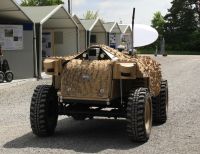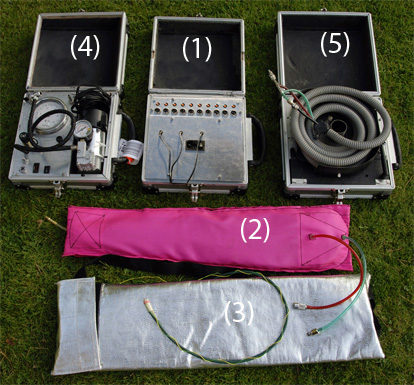The Land robotics system RoboScout consists of a moveable command post and two unmanned ground vehicles (UGV) called Gecko.
The Gecko can be controlled over various communication channels. There is the possibility to control the Gecko through a satellite or terrestrial radio from a plane as a relay station to increase the communication range.
The commanding post can also steer the Gecko with its stationary, terrestrial antenna for close range operations. Even through a computer that is carried along by a soldier, the vehicle can be steered via WLAN on short distance.
Field of application
The system RoboScout can operate and support the following field of apllications:
- Patrol
- Escort
- Object protection
- Advanced observer
- Reconnaissance patrol
- Decoy for enemy forces
- Reconnaissance and monitoring missions
- Fire support
- Konvoi
- Logistical support, transport missions
- Border patrol
You can find further information about the Gecko here:
Waffensysteme->Landsysteme->Deutschland — Gecko — Unbemanntes Landfahrzeug/Unmanned Ground Vehicle (UGV)
MACE 2 — Autonomous Unmanned Ground Vehicle (UGV)
MIRA’s MACE 2 UGV is a multi-application platform and is capable to fulfill various fields of application like:
- Cargo transport
- Convoy
- IED detection
- Medical assistance
- Weapons support
- Patrol duty
- Reconnaissance
- Surveillance
 |
| MACE 2 Click to enlarge |
The MACE 2 with its top speed of 80 mph can easily keep pace with manned vehicles and its payload of a ton load capacity is ideal for convoy support. Another field of application is the operation in surveillance and reconnaissance missions. The vehicle can be equipped depending on the mission with various sensors like laser, ultra-sonic etc., with a weapon station and an IED detection system.
The propulsion is a four-wheel-drive with a diesel engine that provides endurance for 8 hours. The MACE 2 can be driven remotely by person via a powerful non line-of-sight communications with a 5 km range by using tele-op control. The commander maintains situational awareness through a tilt and pan camera.
One person is able to control multiple platforms because of the full autonomous control/mode where the MACE 2 itself can sense its surroundings because of the advantages of binocular vision and radar. In case of obstacles the onboard obstacle avoidance and route re-planning algorithms allow the vehicle to maneuver safely through the obstacles.
The MACE 2 has two autonomous control modes: A waypoint mode where waypoints have been flagged as points of interest through satellite or loitering drone intelligence and a zone control mode which is ideal for patrol duty or for scanning/clearing areas of IEDs.
The field of IED detection has become a priority in the recent operational theaters and in partnership with Roke Manor Research Ltd. (a Siemens Company) MIRA Ltd. has developed an IED detection system that combines the long range capability of ground penetrating radar (GPR) with a short range and high accuracy detection solution.
If an IED or other threats has been detected the MACE 2 transfers the information through a high speed encrypted data link to the base.
For video footage about the MACE 2 please click the following link:
Defence News->Sonderausgabe->M‑ELROB-> ELROB 2010 — Filmgallerie
For pictures about the MACE 2 please click the following link:
Defence News->Sonderausgabe->M‑ELROB-> ELROB 2010 — Bildergallerie
Specifications
| ||||||||||||||||||||
| ||||||||||||||||||||
| ||||||||||||||||||||
| Type: | Digital videolink / Digital point to point control | |||||||||||||||||||
| Frequency: | L‑Band and UHF | |||||||||||||||||||
| Number of Channels: | 8 | |||||||||||||||||||
| Sensor equipment | |
| Laser: | 3 x Sick Lidar |
| Vision: | OPS Optical Position System |
| GPS: | Omnistar |
| Other sensors: | Ultra sonic, inertial |
Source: MIRA Ltd. | |

 von
von 
